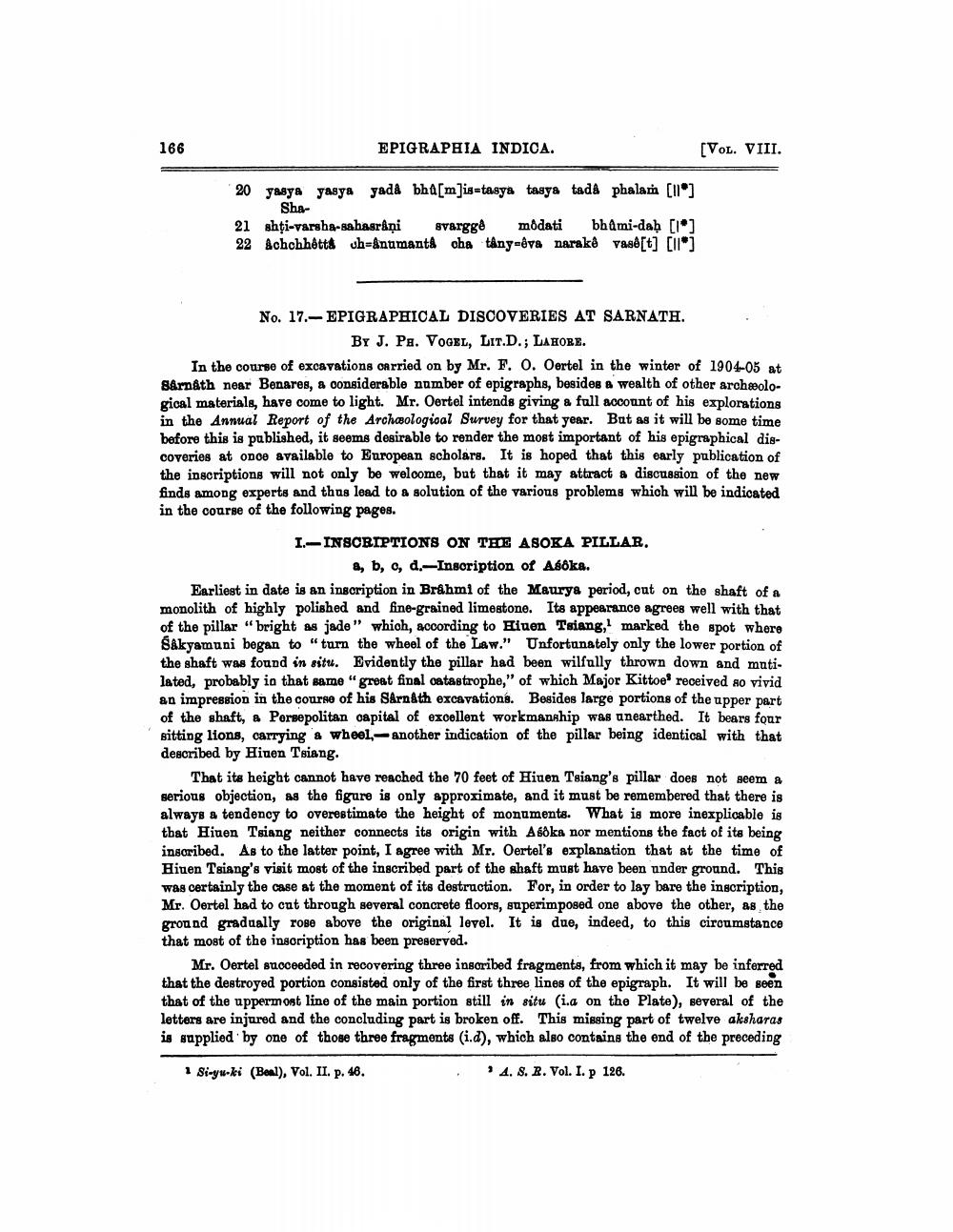________________
166
EPIGRAPHIA INDICA.
(VOL. VIII.
20 yasya yasya yadá bh[m]is-tasya tasya tad& phalaria (11"]
She21 shţi-varsha-sahasråņi vargge modati bhQmi-daḥ [1] 22 Achchhêtts ch=Anumanta cha tany-dva narakê vase[t] [ll]
No. 17.-EPIGRAPHICAL DISCOVERIES AT SARNATH.
BY J. Pa. VOGEL, LIT.D.; LAHORE. In the course of excavations carried on by Mr. F. O. Oertel in the winter of 1904-05 at 8&rnáth near Benares, & considerable number of epigraphs, besides a wealth of other archeological materials, have come to light. Mr. Oertel intends giving a full account of his explorations in the Annual Report of the Archeologioal Survey for that year. But as it will be some time before this is published, it seems desirable to render the most important of his epigraphical discoveries at once available to European scholars. It is hoped that this early publication of the inscriptions will not only be welcome, but that it may attract a discussion of the new finds among experts and thus lead to a solution of the various problems which will be indicated in the course of the following pages.
I.-INSCRIPTIONS ON THE ASOKA PILLAR,
a, b, c, d, -Inscription of Asoka. Earliest in date is an inscription in Brahmi of the Maurya period, cut on the shaft of a monolith of highly polished and fine-grained limestone. Its appearance agrees well with that of the pillar "bright as jade" which, according to Hiuen Tsiang, marked the spot where Sakyamuni began to "turn the wheel of the Law." Unfortunately only the lower portion of the shaft was found in situ. Evidently the pillar had been wilfully thrown down and mati. lated, probably in that same "great final oatastrophe," of which Major Kittoe received so vivid an impression in the course of his Sárnáth excavations. Besides large portions of the upper part of the shaft, a Persepolitan capital of excellent workmanship was unearthed. It bears four sitting lions, carrying a wheel, another indication of the pillar being identical with that described by Hiuen Tsiang.
That its height cannot have reached the 70 feet of Hiuen Triang's pillar does not seem a serious objection, as the figure is only approximate, and it must be remembered that there is always a tendency to overestimate the height of monuments. What is more inexplicable is that Hinen Tsiang neither connects its origin with Asoka nor mentions the fact of its being inscribed. As to the latter point, I agree with Mr. Oertel's explanation that at the time of Hinen Tsiang's visit most of the inscribed part of the shaft must have been under ground. This was certainly the case at the moment of its destruction. For, in order to lay bare the inscription, Mr. Oertel had to cut through several concrete floors, superimposed one above the other, as the ground gradually rose above the original level. It is due, indeed, to this circumstance that most of the inscription has been preserved.
Mr. Oertel succeeded in recovering three inscribed fragments, from which it may be inferred that the destroyed portion consisted only of the first three lines of the epigraph. It will be seen that of the uppermost line of the main portion still in situ (i.a on the Plate), several of the letters are injured and the concluding part is broken off. This missing part of twelve aksharas is supplied by one of those three fragments (i.d), which also contains the end of the preceding
1 Si-yu-ki (Beal), Vol. II. p. 46.
4. 8. R. Vol. I. p 126.




